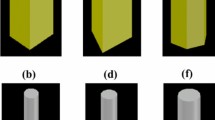Abstract
Electrochemical machining (ECM) has been increasingly recognized as a potential tool for mini-scale machining. Using the ECM process to erode a hole of hundreds of micrometres on a thin metal sheet is analysed in this paper. The purpose of this study is to predict the hole formation, particularly when boring through the hole. A theoretical method is presented to illustrate how the machined profile evolves. The analysis is based on the fundamental law of electrolysis and the integral of the electrochemical reaction over the finite width of the tool electrode. A concept of redistribution of electric charge is adopted in the model when the hole is bored through. The approach of the model is verified experimentally.
Similar content being viewed by others
References
Fontana MB (1966) Corrosion Engineering. McGraw-Hill, New York
McGeough JA (1974) Principle of electrochemical machining. Chapman & Hall, London
Rajurkr KP et al. (1992) Electrochemical Polishing of Biomedical Titanium Orifice Rings. J Mater Proc Technol 35:83–91
Riggo OL, Locke CE (1981) Anodic Protection. Plenum Press, New York
Bhattacharyya B, Doloi B, Sridhar PS (2001) Electrochemical micro-machining: new possibilities for micro-manufacturing. J Mater Proc Technol 113:301–305
Kunieda M, Yoshida M, Yoshida H (1993) Influence of microindents formed by electrochemical jet machining on rolling bearing fatigue life. Manuf Sci Eng, ASME, PED 64:693–699
Datta M, Shenoy RV, Romankiw LT (1993) Recent advances in the study of electrochemical micromachining. ASME, PED 64:675–692
Masuzawa T, Tonshoff HK (1997) Three-dimensional micromachining by machine tools. Ann CIRP 46(2):621–628
Hardisty H, Mileham AR, Shirvani H (1995) Analysis and computer simulation of the electrochemical machining process: a stepped moving tool eroding a plane surface. Proc Inst Mech Eng 210:109–118
De Silva AKM, Altena HSJ, McGeough JA (2000) Precision ECM by process characteristic modeling. Ann CIRP 49(1):151–155
Ruszaj A, Zybura-Skrabalak M (2001) The mathematical modeling of electrochemical machining with flat ended universal electrodes. J Mater Proc Technol 109:333–338
Kwok YK, Wu CCK (1996) Numerical simulation of electrochemical diffusion-migration model with reaction at electrodes. Comput Methods Appl Mech Eng 132:305–317
Zeng CL, Wang W, Wu WT (2001) Electrochemical impedance models for molten salt corrosion. Corrosion Sci 43:787–801
Bhattacharyya B, Sorkhel SK (1999) Investigation for controlled electrochemical machining through response surface methodology-based approach. J Mater Proc Technol 86:200–207
Clifton D, Mount AR, Jardine DJ, Roth R (2001) Electrochemical machining of gamma titanium aluminide intermetallics. J Mater Proc Technol 108:338–348
Suter T, Bohni H (2001) Microelectrodes for corrosion studies in microsystems. Electrochim Acta 47:191–199
Schultze JW, Bressel A (2001) Principles of electrochemical micro- and nano-system technologies. Electrochim Acta 47:3–21
Kozak J (1998) Mathematical models for computer simulation of electrochemical machining process. J Mater Proc Technol 76:170–175
Kuznetsov AM, Medvedev IG (2001) A model of the surface molecule for adiabatic electrochemical electron transfer including electron correlation effects: the exact solution. J Electroanal Chem 502:15–35
Author information
Authors and Affiliations
Corresponding author
Rights and permissions
About this article
Cite this article
Hocheng, H., Kao, P. & Lin, S. Development of the eroded opening during electrochemical boring of hole. Int J Adv Manuf Technol 25, 1105–1112 (2005). https://doi.org/10.1007/s00170-003-1954-x
Received:
Accepted:
Published:
Issue Date:
DOI: https://doi.org/10.1007/s00170-003-1954-x




